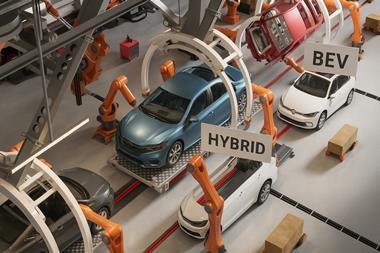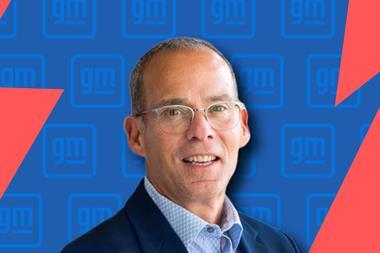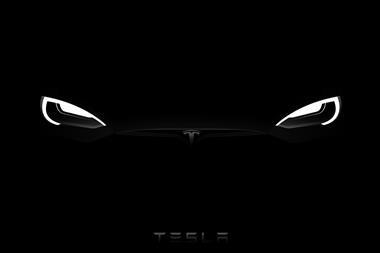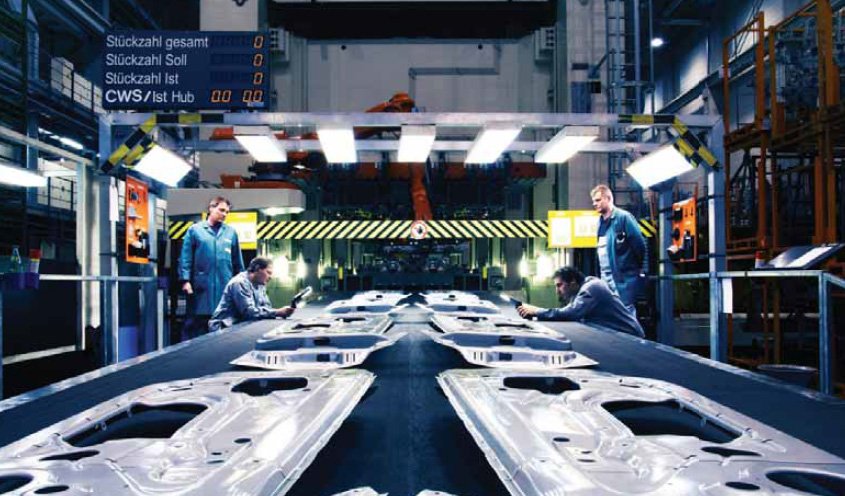
- Material selection
- Optimum multi-material solutions
- Lightweight materials impact NVH
- High-strength applications
- Multi-material future
- Body closures offer future potential
- Strength is rarely the deciding factor
- New forces for change
- Alternative vehicle architectures and electric power
- Sustainability of manufacturing operations
Over recent years, the on-going contest between lobbyists working on behalf of the steel and aluminium industries has become increasingly raucous as they try to convince the wider audience that their respective material holds the key to the future of automotive production.
The tale is a familiar one. Legislative pressure surrounding issues such as fuel efficiency and crashworthiness forces carmakers to target vehicle weight reduction in order to achieve these mandated goals. Yet to reduce weight in today’s ever more sophisticated and complex vehicles is to battle against the trend - simply making each new model similar in weight to the preceding example is a real achievement. This means that traditional patterns of material usage have to be reassessed, which presents new challenges to material suppliers.
Material selection
It is against this background that both the aluminium and steel industries have sought to champion their products. Fortunately, the benefits of their products outweigh any related spin, as each has introduced new and innovative solutions. This has had an influential role in body design and body-in-white (BIW) manufacturing; as BIW accounts for an average of 30% of a given vehicle’s total weight, it is no surprise that this has been the area of most intense controversy - and development.
These developments quickly do away with the basic notion that would see traditional steel grades replaced by either high-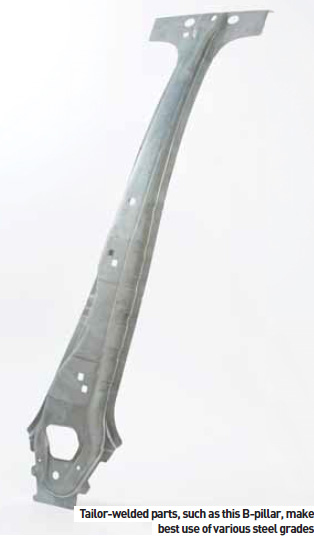 strength steels or aluminium. Instead, the process is much more complex. Each material brings with it a set of requirements in terms of preparation, jointing, shaping and configuration which must be respected and incorporated if vehicle designs are to make full use of a given material’s benefits. Then there are issues surrounding cost; manufacturing and repair implications must be factored into the materials selection process.
strength steels or aluminium. Instead, the process is much more complex. Each material brings with it a set of requirements in terms of preparation, jointing, shaping and configuration which must be respected and incorporated if vehicle designs are to make full use of a given material’s benefits. Then there are issues surrounding cost; manufacturing and repair implications must be factored into the materials selection process.
Even with all these variables entered into the equation, how a vehicle’s material choice will impact its overall environmental legacy must also be taken into consideration. For a full understanding of how this will impact different areas, a full life cycle assessment has to be undertaken, which can radically change the initial perceptions of a material’s assumed merits. It is against the ever-shifting background that designers and engineers look to uncover the optimum solution.
The last decade has seen engineers taking an increasingly holistic approach to the issues surrounding impact absorption. To meet rigorous intrusion standards, the total vehicle structure has required a reassessment, with detailed research into load absorption patterns and crash management systems. Such a wide-ranging process has allowed material suppliers the opportunity to gain influence by providing new solutions at a time when the established patterns of material choice were in serious flux.
Optimum multi-material solutions
New vehicle applications show how both aluminium and steel can contribute viable material solutions. Modular front end crash management systems frequently use aluminium extrusions for bumper support sections and longitudinal arms, combined with high-strength steel chassis legs frequently formed through the use of tailored blanks using different steel compositions to allow controlled energy absorption through progressive crumpling. In other applications, aluminium honeycomb or convoluted tubular structures are used to dissipate energy. High-strength steels have a part to play in such structures, but most manufacturers find that a combination of aluminium and various grades of advanced high-strength steel offer the optimum combination in terms of cost and performance. Insiders from both the aluminium and steel industries recognize that the priority is to devise the most appropriate solution for their customers.
One area of BIW where aluminium has made significant advances is in its use as bonnets and front-end shroud panel work, where the combination of weight saving and its ability to progressively deform under pedestrian impact make it a good choice. However, whether the material can be used is largely dependent on styling choices, as the deeply-fluted shapes called for in some designs can be difficult to achieve using cold stamping.
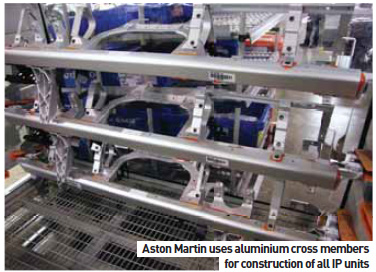 Superplastic forming processes offer an answer, and this is widely used in part production for luxury vehicles, but cost is an issue for mass-market application. Surface finishing is crucial for such high visibility exterior panels, but this is an area where aluminium suppliers are used to meeting the high standards required by premium carmakers. Aside from this, some manufacturers have successfully used nonmetallic front-end exterior panels, a trend which is likely to continue where cost reduction is not a priority. Front bulkhead and suspension towers are important areas where both steel and aluminium can make valuable contributions. Imaginative use of castings can provide structures of impressive strength and offer an attractive degree of component integration. That aside, similar results can be achieved using traditional fabricated steel components, incorporating a variety of different steel grades and section thicknesses to deliver the necessary performance criteria. Steel used in this way can sometimes offer packaging advantages in cramped engine bays where space is at a premium.
Superplastic forming processes offer an answer, and this is widely used in part production for luxury vehicles, but cost is an issue for mass-market application. Surface finishing is crucial for such high visibility exterior panels, but this is an area where aluminium suppliers are used to meeting the high standards required by premium carmakers. Aside from this, some manufacturers have successfully used nonmetallic front-end exterior panels, a trend which is likely to continue where cost reduction is not a priority. Front bulkhead and suspension towers are important areas where both steel and aluminium can make valuable contributions. Imaginative use of castings can provide structures of impressive strength and offer an attractive degree of component integration. That aside, similar results can be achieved using traditional fabricated steel components, incorporating a variety of different steel grades and section thicknesses to deliver the necessary performance criteria. Steel used in this way can sometimes offer packaging advantages in cramped engine bays where space is at a premium.
Lightweight materials impact NVH
Neither steel nor aluminium holds an obvious advantage when it comes to noise, vibration and harshness (NVH) issues. Yet each combination of materials and each manufacturing process will potentially impact upon this area. Reduced panel thickness may have related weight benefits, but increased resonance or unsatisfactory NVH performance is difficult to predict in advance and can present designers and development engineers with myriad problems. The more simulation tools that can be developed, with the appropriate test data to support these simulations, the more adventurous engineers are likely to be in their choice of materials.
Elsewhere in the modern vehicle, complex aluminium castings and extrusions are increasingly being considered for use inhidden structures such as cockpit carriers or instrument panel beams. In these components, a complex mix of requirements is evident. Their structural contribution is an important tool in improving overall body stiffness and impact energy absorption, while their rigid construction assists with NVH issues. Substitution of aluminum for steel is not in these circumstances just a question of weight or cost. Instead, the characteristics of the chosen material can actually enhance various aspects of vehicle behaviour. Vehicle floor pan and sill areas remain largely the preserve of steel. Whilst Audi and Jaguar have shown the potential of all-aluminium body shells for volume applications, the overwhelming majority of vehicles use steel pressings for these areas. To meet demanding side intrusion targets, sill and door pillar areas benefit from the use of advanced highstrength steel grades. With the introduction of products with higher tensile strengths, the trend has been to use thinner gauge material even in these high stress areas.
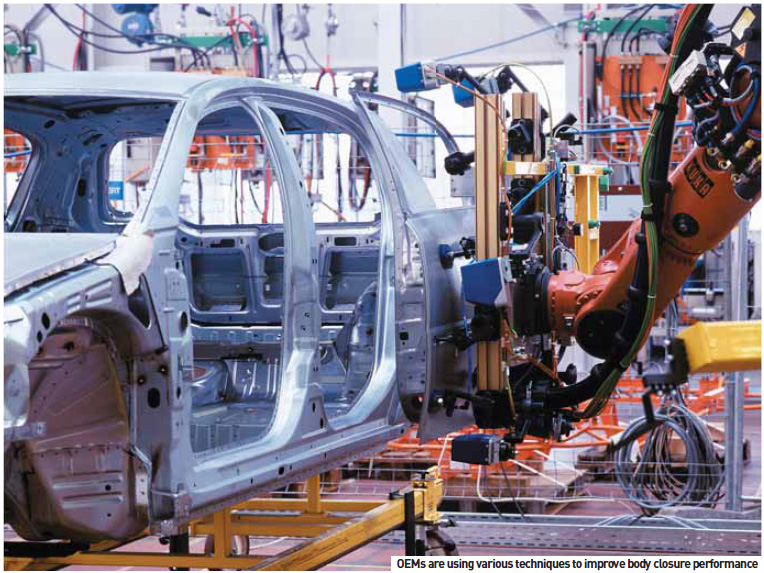
High-strength applications
ArcelorMittal points to the company’s highest-performing products achieving 1,500Mpa - the goal is to reach 2,000Mpa in the near future. Hydroforming and tailored blank solutions are used in the pillar areas, combining different steel grades in a single B-pillar component, which allows the reproduction of complex shapes and residual elongation at the bottom of the part. Tailor-welded blanks incorporating UHSS hot stamping grades with milder materials further allows further weight savings to be achieved. Floorpan pressings themselves present a particular challenge as the deeply-drawn shapes frequently limit the extent to which the higher-performing steel grades can be used. Instead, easily formable mild steel sheet is used for the pans themselves, which where appropriate is supplemented with cross members and panelwork made from higher grade material.
Roof side rails and A- and B-pillars are fundamental in determining side intrusion and rollover protection. It is in these areas that manufacturers are able to use the enhanced strength of new steel grades to provide higher levels of protection, without associated weight increases. Nissan, in collaboration with Nippon Steel Corporation and Kilbe Steels, are using 1,200Mpa UHSS for roof side rails and B-pillar reinforcement. The material can be cold formed, allowing it to be used in a mass-market application. In this instance weight saving takes second place to overall strength, which translates to reduced screen pillar widths that return appropriate crash performance and overall torsional stiffness.
Steel can, of course, be combined with aluminium roof panels. The new Range Rover Evoque uses the combination of a steel body with an aluminium roof panel, made from a new, high-strength alloy from Novelis. The company’s Ac-600-PX sheet (where Ac stands for anticorodal) is significantly stronger than the most common aluminium sheet previously used for BIW applications. As a consequence, this has meant all performance targets could be achieved despite a 25% reduction in panel thickness. Obviously weight reduction in this upper body area is especially significant, helping to lower the vehicle’s centre of gravity and improving handling response.
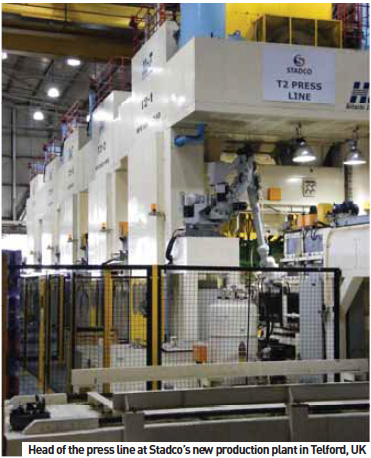 Multi-material future
Multi-material future
The continuing development of sophisticated jointing technologies is crucial to the development of multimaterial body shells. Unlike low-volume aerospace usage, the mass-market motor industry demands adhesive and jointing solutions which are compatible with high-volume production, assembly and paint application processes. In the case of the Evoque, collaboration between Novelis and the Jaguar Land Rover resulted in the roof panel being attached by rivets, which are in turn supplemented by an epoxy adhesive. While a very high strength joint can be achieved using the epoxy alone, aluminium panels can remain prone to peeling stress which is negated by use of a mechanical fixing such as rivets.
Both the steel and aluminium industries are conscious of the impact composite materials are making in specialist lowvolume sectors. Yet as volumes increase, the potential weight savings offered by materials including carbon fibre tend to be eroded.
The consistent global availability of sheet materials – be it steel or aluminium – is an essential prerequisite for efficient production. Daniel Jubera, Automotive Sales and Marketing Director for Novelis, points out that the company has invested heavily in ensuring global availability of the supplier’s full range of product. Steel producers likewise have been keen to ensure that they can respond to the global character of automotive production.
Body closures offer future potential
Some of the most innovative uses of both aluminium and new high-strength steels are to be found in body closures or ‘hanging’ panels. In part, this is due to the increasing sophistication of these parts. Crash impact protection requires doors and tailgates to assist in the process of retaining passenger cell integrity. The complexity of the internal door structures, along with efficient weather sealing and noise reduction, have all tended to increase weight and cost of production. At Ferrari, doors feature diecast alloy frames with machined panel attachment points, reinventing a traditional Italian engineering process that was widely apparent many decades ago.
Sophistication of this kind is not confined to low volume, niche manufacturers. The BMW 5 and 7 Series models nowfeature a door structure developed in conjunction with Novelis. A multi-layer ‘Fusion’ technology has enabled BMW to manufacture one-piece aluminium door structures, with integral window frames, to a design that is not achievable with conventional aluminium sheet. The result is a 25% weight reduction of the door when compared with a similar steel design. According to BMW, it is the unique combination of core properties and surface characteristics provided by the multi-alloy composition of Novelis Fusion that makes this possible.
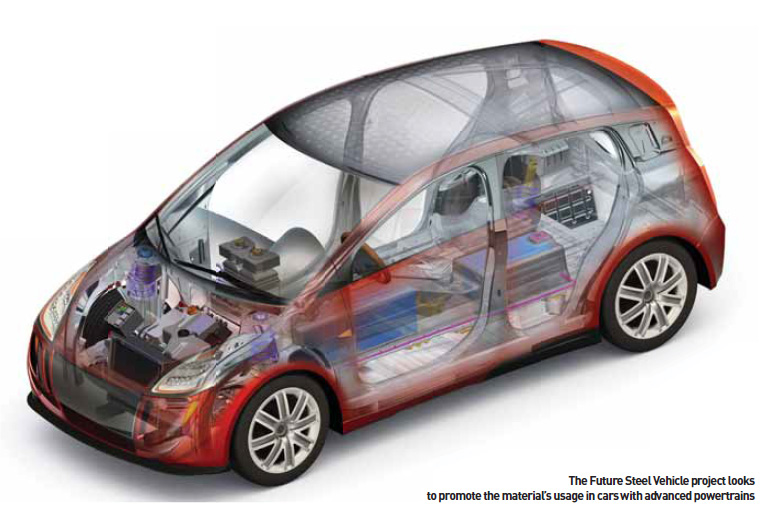
Use of multi-layer alloys may be required in some applications, but the real opportunities for growth in the mass market still involve more conventional, single-grade sheet. Jubera says the company will look to meet an OEM’s needs with single-layer products wherever possible, while offering the option of a more sophisticated multi-layer fusion technology. Similarly, with steel products, it is the dual-phase steels that remain most popular, but suppliers report increasing demand for grades that enable the stamping of complex components at up to 800Mpa.
Strength is rarely the deciding factor
As stated, strength is only one factor when deciding which material to use. For its part, Honda recently stated that it was approaching the natural limits when it came to using high-strength steels, which is further complicated when attempting to achieve lighter vehicle weights through reduced material gauges.
Transformation Induced Plasticity (TRIP) steels present a new compromise between strength and formability, while Twinning Induces Plasticity (TWIP) steels go one step further, combining high strength with improved formability. These also retain significant ductility after stamping, which can return improved impact energy absorption characteristics. Rear floor pan areas often have high stress rear suspension mountings that can benefit from being formed from high-strength steels, while aluminium is increasingly being considered for tailgates. Thin gauge, highstrength aluminium sheet can now offer appropriate levels of dent resistance and hemming performance to make it an option even for mass-market vehicles.
New forces for change
Body structures are by far the most capital intensive part of automotive production, whatever material is being used. This in itself has an influence on the material selection processes. An analysis by Stadco – a major specialist automotive pressing and stamping services supplier – identifies interesting OEM trends related to recent global economic problems.
In the company’s view although model proliferation will continue, it will be against a background of increasing sensitivity to the investment costs associated with new model derivatives. Increasingly, OEMs may be willing to outsource production of large exterior skin pressings that that has been part of the company’s core capability. Stadco has responded to this outsourcing opportunity by developing appropriate capacity. With the capability to work with either steel or aluminium, and the flexibility to respond to a carmaker’s needs, this could also encourage something of a paradigm shift in the material selection processes.
It would clearly be wrong to speak of tradition and inertia as major factors preventing change within automotive production, given its highly competitive nature and track record of innovation. Nevertheless, changes in the commercial and organisational environments can often release innovation in unexpected ways. A key to the adoption of new materials is the ability to envisage and explore alternatives. Outsourcing brings new bodies of knowledge and new approaches, which requires even closer co-operation across design and development areas.
Alternative vehicle architectures and electric power
The most obvious long-term influence across BIW construction is that of alternative vehicle power sources. Electric and hybrid vehicles are evolving within existing vehicle architectures, but in the long term these vehicles will increasingly impact how vehicles are conceptualised and produced. The impact of EVs, PHEVs and other electric vehicles, driven by range and battery storage, has been to emphasize the importance of lightweight body structures. Within this area, carbon fibre and aluminium are seen as the natural materials for body construction - any associated cost penalty becomes insignificant when compared with the increases in vehicle range.
The aluminium industry certainly sees such developments as a source for increased future business. In the longer term, as volumes increase and battery development progresses, the likelihood is that a greater role may be found for advanced lightweight steel construction. The World Steel Association has addressed these issues, directly commissioning a series of studies to show - in practical terms - the potential of steel in EVs. Most relevant is the long-running Future Steel Vehicle (FSV) initiative, a global programme that aims to develop lightweight steel body concepts for vehicles with advanced powertrains, including plug-in hybrids, EVs or hydrogen fuel cells.
Along with similar design studies put forward by the aluminium industry, these interventions assist OEMs and their supplier partners to establish data evidence that allows informed choice with regards to which material solution to use. As a part of this, focusing on life cycle analysis can develop an understanding of the environmental impact associated with such decisions.
Sustainability of manufacturing operations
As automotive manufacturers become increasingly sensitive to such areas as sustainable operation across manufacturing processes, material choice will not just depend on cost and performance but also on the supplier’s ability to actively support a sustainable growth path. Steel and aluminium producers have moved quickly to develop these capabilities. Novelis, for example, has recently outlined a ‘Sustainability Commitment’ which aims to reduce the lifecycle impact of its core product. Setting a target of 80% recycled material content by 2020, the company works with OEMs to ensure waste material from the production process is effectively managed, which leads to a maximizing of its recycling potential.
Despite the ‘certainties’ presented in a given lobbyists graphs and charts, it is unlikely the future for either steel or aluminium across the automotive sector will a clear ‘victory’ of one over the other. Steel has reinvented itself in recent years and aluminium has shown that the barriers to its use in mass market vehicles can be readily eroded. Both materials look set to forge the future of automotive BIW construction.


































